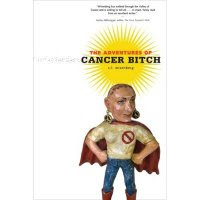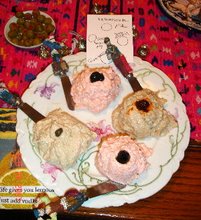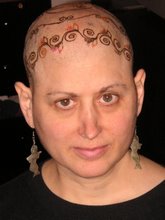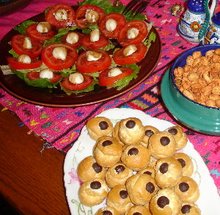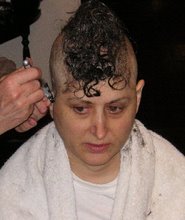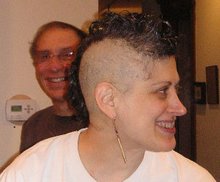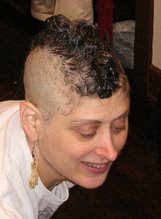So. I've got a new disease. Or condition. It's rare, only five people per million are diagnosed with it annually. I think "people" might mean Americans, or rather, US residents--because "Americans" includes people from the Arctic Archipelago to Tierra del Fuego. But I'm dancing around the point. Attentive readers of this blog will recall that I have too many platelets in my blood (AKA essential thrombocythemia). I've found out I also have too many red blood cells. The official term is polycythemia vera . I have the non-hereditary gene mutation, JAK2, which is found in 95 percent of the people who have this. My hematologist (you know you're in trouble when you have a hematologist) told me yesterday I probably had it, and she looked at my blood results today and confirmed it. I make too many things, I said to the hematologist yesterday--starting with cancer, which is the production of too many cells in an uncontrolled way. She said, Yes, you make too many things. The first-line treatment for this, she told me, comes from the 13th century. Leeches? I asked, because I'd seen an article in the New Yorker about their use but hadn't read the piece yet. Not leeches, she said, but you get a phlebotomy. You go to LifeSource and get a pint taken out. You can't donate this pint because it's filled with too-thick blood. Where does it go? I asked. Probably into a biohazard bag and then to a landfill, she said. I thought of my blood seeping into the earth. Blut und Boden.
It seems a shame to waste this blood. To spill it. If Venus flytraps snap up hamburger meat, couldn't they sup on some blood? Could blood be used as plant food? (Alas, I am finding through the 'net that flytraps feed on bugs, not hamburger meat.) Believe it or not, someone else has thought to ask about feeding blood to the flytraps. Unfortunately, you can't tell if the answers have merit.
So the plan is to give a pint on Tuesday (the first time I could get an appointment) and then two weeks later, then go to Fancy Hospital to get my blood tested, talk to the doctor, and probably have two more sessions two weeks apart. From there I would probably get my "prophylactic phlebotomy" every one, two or three months.
I need to rid myself of this thick blood because otherwise it maybe maybe maybe could cause blood clots, stroke, heart attack. I am a funny person to have this disease because it most often strikes men over 60. I have learned what the signs of a blood clot are and that you can get an ultrasound to show if you have one. If this "venesection," as the Brits call it, doesn't work, then there's Plan B, which involves chemotherapy. Mild. In the form of a pill called hydroxyurea.
There are other funny (strange, not ha-ha) things. My hematologist asked if I had itching. I said, mostly after taking a shower, and she said that's a symptom. It's funny because it's a phenomenon I had noticed but I hadn't thought it meant anything. I also had noticed that my gums were bleeding after flossing, and that's a symptom, too. I also have hot flashes, which is not news to attentive blog readers or anyone who has been in a room with me lately. While flashing, my face and ears turn red. The doctor said that the phlebotomy might help with the redness and sweating. So that's good news. (I keep thinking "lobotomy" and have to remind myself that one is brain and one is blood. No ice picks for Cancer Bitch.)
In case you want a leech of your own, click here. Note that leeches are non-returnable.
About the Bitches
I thought Susan Sontag showed everyone that our personality defects don't cause our cancer. Now we have the lovely bestselling Skinny Bitches telling us the opposite, and I would bet that more people have heard of them than the late Sontag. The authors of Skinny Bitch: A no-nonsense, tough-love guide for savvy girls who want to stop eating crap and start looking fabulous are counseling those savvy girls to go vegan and organic. Nothing wrong with that, except some of their science seems a bit loose. And then we get to page 189, where the Bitches praise, quote and paraphrase case studies from Dr. Carolyn Myss' book, Anatomy of the Spirit. To wit: "It is no coincidence that Julie was diagnosed with breast and ovarian cancer, reflecting her lack of self-love....'Joanna' was married to a man who had multiple affairs, which she knew about but tried to live with. Not surprisingly, she developed breast cancer." But then she confronted her husband, left the marriage--and recovered! Of course!
The authors do say that they're not saying that "everyone suffering from a disease has brought it upon him or herself." But that it's possible. Thank you so much, Skinny Bitches, for blaming us. You can keep your book and your damned soy beans and soy milk and tofu, which I don't eat any more because they act like weak estrogens.
I can't take this book back to the store because I didn't buy it. A co-worker of L's did. She had a lumpectomy and I guess is trying to clean up her act. We are all trying to. But the Skinny Bitches aren't the ones who should be directing us.
The authors do say that they're not saying that "everyone suffering from a disease has brought it upon him or herself." But that it's possible. Thank you so much, Skinny Bitches, for blaming us. You can keep your book and your damned soy beans and soy milk and tofu, which I don't eat any more because they act like weak estrogens.
I can't take this book back to the store because I didn't buy it. A co-worker of L's did. She had a lumpectomy and I guess is trying to clean up her act. We are all trying to. But the Skinny Bitches aren't the ones who should be directing us.
Book Review: Cancer and the Environment
Cancer Bitch is in NJ, recovering from being away from the Internet for a few days. I'll report back soon. In the meantime, here's an important piece.
TIMES ( U.K. ) Online
http://entertainment.timesonline.co.uk/tol/arts_and_entertainment/the_tls/article3277880.ece
January 30, 2008
Theories of cancer
How paradigms shift and culprits change in the fight against the disease, and what concerned citizens can do about it
Sandra Steingraber
Devra DavisSECRET HISTORY OF THE WAR ON CANCER505pp. Basic Books. £16.99.978 0 465 01566 5
Phil BrownTOXIC EXPOSURESContested illnesses and the environmental health movement 356pp. New York : Columbia University Press. £19 (US $29.50).978 0 231 12948 0
One advantage of being a long-time cancer survivor – besides the obvious – is that it provides a front-row seat in the auditorium of ideas about the disease’s causation. Theories go in and out of fashion over the years, paradigms shift this way and that, and the patient is viewed differently by the medical community depending on which idea is currently on top.
I was diagnosed with bladder cancer in 1979, when I was twenty years old and just at the beginning of my career as a biologist. At that time, US newspaper headlines featured Love Canal , the upstate New York community whose residents had been evacuated a year earlier when 20,000 tons of industrial chemicals were discovered buried under their basements. Toxic-waste activism in the United States was in the ascendant, the newly formed US Environmental Protection Agency was committed and passionate, and major environmental legislation had been recently enacted by Congress to defend clean air and clean water in the name of human health.
After breaking the bad news from the pathology lab, my urologist asked me about tyres: automobile tyres. Had I ever vulcanized tyres? His second question was about textile dyes. Any exposure to the colour yellow? And had I ever worked in the aluminium industry?
Back at the university, I began to research the causes of bladder cancer. Indeed, there were data on dyes and bladder cancer going back to the nineteenth century. In fact, there was absolute proof that certain textile dyes caused bladder cancer in humans. And yet, mysteriously, this evidence had not resulted in the abolition of these chemicals from the economy. Other suspected bladder carcinogens, for which the evidence was highly troubling, if not outright damning, were produced and used by the industries in my home town. The National Cancer Institute was generating maps of cancer mortality in an attempt to unveil other possible environmental carcinogens that could explain rising rates of cancer.
And then Ronald Reagan was elected President, and everything changed. No one asked me any more about my possible environmental exposures. In fact, by the mid-1980s, I was hard-pressed to find the word “carcinogen” in any pamphlet on cancer that I collected from my doctors’ various offices. Meanwhile, in the medical literature, the search for cancer clusters that might point towards environmental contributors became a disparaged practice. The new focus of the National Cancer Institute was on “lifestyle” explanations for cancer.
As a young adult I hadn’t really had enough time to develop bad habits. In fact, I was a vegetarian who ran four miles a day. Thus there was no explanation for my situation. “Some kind of fluke”, said one of my doctors. Wherever I lived, I dutifully submitted to cancer check-ups. By the 1990s, the new explanation for cancer was genetic, and I started receiving lots of questions from young intake doctors about my family history. I had fun with this. I would describe in detail my mother, diagnosed with breast cancer, my various uncles with prostate and colon cancers, and – the crowning point – my aunt who died of the same kind of bladder cancer that I had. The young doctors took furious notes. I would always pause a few beats before adding, “Oh yeah. And I’m adopted”. (There is no evidence for a hereditary link to bladder cancer. And there never has been.)
Today, I’m a forty-eight-year-old professor in Ithaca , New York , and during my last renal ultrasound, the technician asked me casually if I’d ever worked with textile dyes. I suppose Al Gore should get the credit: the environment is once again on the collective radar screen.
Two new books expose and explicate the ongoing social contest that is at the heart of our shifting understanding about cancer. They are both important and deserve to be read together. Devra Davis’s book examines the historical forces at work when doubt is cast on the environmental evidence. Phil Brown’s book explores the opposing social movements that are struggling to rescue this evidence and to bring about public health policy change based on it.
Devra Davis’s Secret History of the War on Cancer is a big, sprawling book whose argument is more implicit than it should be. Her autobiographical style – which served her so well in her earlier treatise on public health, When Smoke Ran Like Water – often gets in the way of her analysis here. Nevertheless, Davis, who directs the Center for Environmental Oncology at the University of Pittsburgh Cancer Institute, is an epidemiologist and public-health scientist at the top of her game. In her new book, she reveals what she knows about the interlocking structures of government and corporate interests, and how these relationships have affected the social construction of knowledge about cancer. Davis deserves to be taken seriously as a former adviser to the World Health Organization, a public-health servant in both the Carter and the Clinton Administrations, and the founding director of the Board on Environmental Studies and Toxicology in the National Academy of Sciences.
The basic thesis of this book is that 1.5 million lives have been lost, because Americans failed to act on existing knowledge about the environmental causes of cancer. This failure has been created by at least eight different factors, both acting together and independently of each other. The first is the cowardice of research scientists, who publish thoroughly referenced reports but pull their punches at the end, by claiming that more research needs to be done before action can be taken. Statements like these are then exploited by those who profit from the status quo. Like the cigarette industry during the 1960s, the chemical industry has learned how to buy time and create wholesale public doubt from small data gaps and remaining scientific uncertainties.
Meanwhile, Davis argues, regulatory agencies have become unresponsive to new scientific evidence altogether. Hamstrung by small-government-is-better reforms of the Reagan Administration, environmental and public agencies shrank even as the science began pointing to the need for more regulation. As for the government agencies and charities whose mission it is to eradicate cancer, these institutions, too, have had meaningful work on cancer prevention compromised by corporate interests. Throughout the 1980s, for example, the chief executive officer of Occidental Petroleum served as the chair of the National Cancer Institute’s advisory board. Ultimately, the so-called War on Cancer is not really a war at all, argues Davis , but a cunning re-enactment.
The evolutionary history of epidemiology itself has also played a role in muffling the evidence for environmental harm. With its necessary focus on workers – who are exposed to the highest amounts of suspected carcinogens – epidemiologists require access to industry. The price for access, too often, is the promise of secrecy. Having struck a Faustian bargain, occupational epidemiologists can have – and have had – their funds withdrawn if they go public with their results.
A further factor involves the court system. Davis shows brilliantly the ways in which various kinds of scientific evidence – such as animal research – have been gradually declared inadmissible in legal cases, thanks to clever lawyering. “Basically”, says Davis, “before you can collect damages, you must get cancer or some other awful disease, show that someone else already got it from the same things you did, prove that you had specific exposures to a particular agent, find the firm that caused your harm and can now pay for it, and prove that they knew the exposure was harmful.”
The last two factors involve outright harassment of researchers, including Davis herself, and plain old terrible timing, which has occurred at least twice in the last century, as when major treatises on the environmental contributors to cancer were released, first on the brink of the First World War, and then again right before the Second World War. Indeed, Davis’s crowning achievement with this book is her resuscitation of old publications, along with secret memos and various other original manuscripts, which show how much we used to know about the role that chemical exposures play in the burden of cancer. Some of these were subsequently doctored to serve particular purposes.
The Secret History of the War on Cancer is a remarkable piece of sleuthing from one of our most brave and knowledgeable scientists, on a topic that affects millions. Having closed Davis ’s book, one should immediately open Phil Brown’s Toxic Exposures, which focuses on the ways in which environmental- health activists and their advocates in science are challenging the carcinogen-deniers that Davis writes about. Like Devra Davis, Brown, a medical sociologist at Brown University , has been a researcher in the field of environmental health for several decades, beginning with his groundbreaking work on the Woburn cancer cluster, made famous in the Hollywood movie A Civil Action. His new book represents many years of work. Toxic Exposures can be read as a guidebook for those wishing to understand the environmental-health movement, which, according to Brown, is the Civil Rights movement of our times. As he demonstrates, almost all cases of cancer clusters and contaminated communities, from Love Canal onwards, have been discovered by citizen activists – not by scientists, nor government agencies. This is because no governmental agency or scientific body engages in routine surveillance that would uncover sentinel health events. It is also because cancer registries, which could function as early-warning systems, publish their results in obscure almanacs and do not actively investigate communities where cancer rates are elevated. Often, as Brown notes, these communities are never even informed that their cancer rates are statistically excessive.
But, in the cases where citizens have engaged in their own lay epidemiology and have become environmental detectives in their own communities, new avenues of scientific research have been made possible, which, in turn, have spurred on better environmental decisions. When sympathetic scientists work hand in hand with these activists, new forms of knowledge are created that challenge the lifestyle and hereditary foci of conventional epidemiology.
In one my favourite examples from the book, Brown describes how science alone failed to produce regulations sufficient to reduce lead poisoning among children. It was only the efforts of black and Latino rights groups – most notably the Black Panthers and the Young Lords – in the 1960s that finally led to the social changes necessary to get lead away from children’s brains. Once that happened, science had the human experiment it needed to prove that exposures to an environmental toxicant at levels once considered acceptable and unavoidable were not safe or necessary after all.
Brown’s book systematically examines citizen-science alliances in three disease areas: breast cancer, asthma and Gulf War Syndrome as reported by US veterans of the first Iraq war. While individual readers who are not sociologists will no doubt be drawn, by personal experience, to one of the three, all offer important lessons about the construction of scientific knowledge. It was fascinating to learn, for example, how environmental -justice activists working on asthma clusters in urban areas are now forcing scientists to investigate the health effects of very fine particles, which are not yet regulated by the Environmental Protection Agency.
In the end, Phil Brown’s analysis of contested illnesses makes a strong case for better health tracking to monitor diseases, and better chemicals tracking to monitor the flow of hazardous substances in consumer goods, in the jet stream, in our groundwater, and in our tuna-fish sandwiches. Toxic Exposures also makes clear that neither will happen without citizen participation in the scientific process.
Sandra Steingraber is the author of Living Downstream: An ecologist looks at cancer and the environment, 1997, and Having Faith: An ecologist's journey to motherhood, 2001.
TIMES ( U.K. ) Online
http://entertainment.timesonline.co.uk/tol/arts_and_entertainment/the_tls/article3277880.ece
January 30, 2008
Theories of cancer
How paradigms shift and culprits change in the fight against the disease, and what concerned citizens can do about it
Sandra Steingraber
Devra DavisSECRET HISTORY OF THE WAR ON CANCER505pp. Basic Books. £16.99.978 0 465 01566 5
Phil BrownTOXIC EXPOSURESContested illnesses and the environmental health movement 356pp. New York : Columbia University Press. £19 (US $29.50).978 0 231 12948 0
One advantage of being a long-time cancer survivor – besides the obvious – is that it provides a front-row seat in the auditorium of ideas about the disease’s causation. Theories go in and out of fashion over the years, paradigms shift this way and that, and the patient is viewed differently by the medical community depending on which idea is currently on top.
I was diagnosed with bladder cancer in 1979, when I was twenty years old and just at the beginning of my career as a biologist. At that time, US newspaper headlines featured Love Canal , the upstate New York community whose residents had been evacuated a year earlier when 20,000 tons of industrial chemicals were discovered buried under their basements. Toxic-waste activism in the United States was in the ascendant, the newly formed US Environmental Protection Agency was committed and passionate, and major environmental legislation had been recently enacted by Congress to defend clean air and clean water in the name of human health.
After breaking the bad news from the pathology lab, my urologist asked me about tyres: automobile tyres. Had I ever vulcanized tyres? His second question was about textile dyes. Any exposure to the colour yellow? And had I ever worked in the aluminium industry?
Back at the university, I began to research the causes of bladder cancer. Indeed, there were data on dyes and bladder cancer going back to the nineteenth century. In fact, there was absolute proof that certain textile dyes caused bladder cancer in humans. And yet, mysteriously, this evidence had not resulted in the abolition of these chemicals from the economy. Other suspected bladder carcinogens, for which the evidence was highly troubling, if not outright damning, were produced and used by the industries in my home town. The National Cancer Institute was generating maps of cancer mortality in an attempt to unveil other possible environmental carcinogens that could explain rising rates of cancer.
And then Ronald Reagan was elected President, and everything changed. No one asked me any more about my possible environmental exposures. In fact, by the mid-1980s, I was hard-pressed to find the word “carcinogen” in any pamphlet on cancer that I collected from my doctors’ various offices. Meanwhile, in the medical literature, the search for cancer clusters that might point towards environmental contributors became a disparaged practice. The new focus of the National Cancer Institute was on “lifestyle” explanations for cancer.
As a young adult I hadn’t really had enough time to develop bad habits. In fact, I was a vegetarian who ran four miles a day. Thus there was no explanation for my situation. “Some kind of fluke”, said one of my doctors. Wherever I lived, I dutifully submitted to cancer check-ups. By the 1990s, the new explanation for cancer was genetic, and I started receiving lots of questions from young intake doctors about my family history. I had fun with this. I would describe in detail my mother, diagnosed with breast cancer, my various uncles with prostate and colon cancers, and – the crowning point – my aunt who died of the same kind of bladder cancer that I had. The young doctors took furious notes. I would always pause a few beats before adding, “Oh yeah. And I’m adopted”. (There is no evidence for a hereditary link to bladder cancer. And there never has been.)
Today, I’m a forty-eight-year-old professor in Ithaca , New York , and during my last renal ultrasound, the technician asked me casually if I’d ever worked with textile dyes. I suppose Al Gore should get the credit: the environment is once again on the collective radar screen.
Two new books expose and explicate the ongoing social contest that is at the heart of our shifting understanding about cancer. They are both important and deserve to be read together. Devra Davis’s book examines the historical forces at work when doubt is cast on the environmental evidence. Phil Brown’s book explores the opposing social movements that are struggling to rescue this evidence and to bring about public health policy change based on it.
Devra Davis’s Secret History of the War on Cancer is a big, sprawling book whose argument is more implicit than it should be. Her autobiographical style – which served her so well in her earlier treatise on public health, When Smoke Ran Like Water – often gets in the way of her analysis here. Nevertheless, Davis, who directs the Center for Environmental Oncology at the University of Pittsburgh Cancer Institute, is an epidemiologist and public-health scientist at the top of her game. In her new book, she reveals what she knows about the interlocking structures of government and corporate interests, and how these relationships have affected the social construction of knowledge about cancer. Davis deserves to be taken seriously as a former adviser to the World Health Organization, a public-health servant in both the Carter and the Clinton Administrations, and the founding director of the Board on Environmental Studies and Toxicology in the National Academy of Sciences.
The basic thesis of this book is that 1.5 million lives have been lost, because Americans failed to act on existing knowledge about the environmental causes of cancer. This failure has been created by at least eight different factors, both acting together and independently of each other. The first is the cowardice of research scientists, who publish thoroughly referenced reports but pull their punches at the end, by claiming that more research needs to be done before action can be taken. Statements like these are then exploited by those who profit from the status quo. Like the cigarette industry during the 1960s, the chemical industry has learned how to buy time and create wholesale public doubt from small data gaps and remaining scientific uncertainties.
Meanwhile, Davis argues, regulatory agencies have become unresponsive to new scientific evidence altogether. Hamstrung by small-government-is-better reforms of the Reagan Administration, environmental and public agencies shrank even as the science began pointing to the need for more regulation. As for the government agencies and charities whose mission it is to eradicate cancer, these institutions, too, have had meaningful work on cancer prevention compromised by corporate interests. Throughout the 1980s, for example, the chief executive officer of Occidental Petroleum served as the chair of the National Cancer Institute’s advisory board. Ultimately, the so-called War on Cancer is not really a war at all, argues Davis , but a cunning re-enactment.
The evolutionary history of epidemiology itself has also played a role in muffling the evidence for environmental harm. With its necessary focus on workers – who are exposed to the highest amounts of suspected carcinogens – epidemiologists require access to industry. The price for access, too often, is the promise of secrecy. Having struck a Faustian bargain, occupational epidemiologists can have – and have had – their funds withdrawn if they go public with their results.
A further factor involves the court system. Davis shows brilliantly the ways in which various kinds of scientific evidence – such as animal research – have been gradually declared inadmissible in legal cases, thanks to clever lawyering. “Basically”, says Davis, “before you can collect damages, you must get cancer or some other awful disease, show that someone else already got it from the same things you did, prove that you had specific exposures to a particular agent, find the firm that caused your harm and can now pay for it, and prove that they knew the exposure was harmful.”
The last two factors involve outright harassment of researchers, including Davis herself, and plain old terrible timing, which has occurred at least twice in the last century, as when major treatises on the environmental contributors to cancer were released, first on the brink of the First World War, and then again right before the Second World War. Indeed, Davis’s crowning achievement with this book is her resuscitation of old publications, along with secret memos and various other original manuscripts, which show how much we used to know about the role that chemical exposures play in the burden of cancer. Some of these were subsequently doctored to serve particular purposes.
The Secret History of the War on Cancer is a remarkable piece of sleuthing from one of our most brave and knowledgeable scientists, on a topic that affects millions. Having closed Davis ’s book, one should immediately open Phil Brown’s Toxic Exposures, which focuses on the ways in which environmental- health activists and their advocates in science are challenging the carcinogen-deniers that Davis writes about. Like Devra Davis, Brown, a medical sociologist at Brown University , has been a researcher in the field of environmental health for several decades, beginning with his groundbreaking work on the Woburn cancer cluster, made famous in the Hollywood movie A Civil Action. His new book represents many years of work. Toxic Exposures can be read as a guidebook for those wishing to understand the environmental-health movement, which, according to Brown, is the Civil Rights movement of our times. As he demonstrates, almost all cases of cancer clusters and contaminated communities, from Love Canal onwards, have been discovered by citizen activists – not by scientists, nor government agencies. This is because no governmental agency or scientific body engages in routine surveillance that would uncover sentinel health events. It is also because cancer registries, which could function as early-warning systems, publish their results in obscure almanacs and do not actively investigate communities where cancer rates are elevated. Often, as Brown notes, these communities are never even informed that their cancer rates are statistically excessive.
But, in the cases where citizens have engaged in their own lay epidemiology and have become environmental detectives in their own communities, new avenues of scientific research have been made possible, which, in turn, have spurred on better environmental decisions. When sympathetic scientists work hand in hand with these activists, new forms of knowledge are created that challenge the lifestyle and hereditary foci of conventional epidemiology.
In one my favourite examples from the book, Brown describes how science alone failed to produce regulations sufficient to reduce lead poisoning among children. It was only the efforts of black and Latino rights groups – most notably the Black Panthers and the Young Lords – in the 1960s that finally led to the social changes necessary to get lead away from children’s brains. Once that happened, science had the human experiment it needed to prove that exposures to an environmental toxicant at levels once considered acceptable and unavoidable were not safe or necessary after all.
Brown’s book systematically examines citizen-science alliances in three disease areas: breast cancer, asthma and Gulf War Syndrome as reported by US veterans of the first Iraq war. While individual readers who are not sociologists will no doubt be drawn, by personal experience, to one of the three, all offer important lessons about the construction of scientific knowledge. It was fascinating to learn, for example, how environmental -justice activists working on asthma clusters in urban areas are now forcing scientists to investigate the health effects of very fine particles, which are not yet regulated by the Environmental Protection Agency.
In the end, Phil Brown’s analysis of contested illnesses makes a strong case for better health tracking to monitor diseases, and better chemicals tracking to monitor the flow of hazardous substances in consumer goods, in the jet stream, in our groundwater, and in our tuna-fish sandwiches. Toxic Exposures also makes clear that neither will happen without citizen participation in the scientific process.
Sandra Steingraber is the author of Living Downstream: An ecologist looks at cancer and the environment, 1997, and Having Faith: An ecologist's journey to motherhood, 2001.
Subscribe to:
Posts (Atom)
